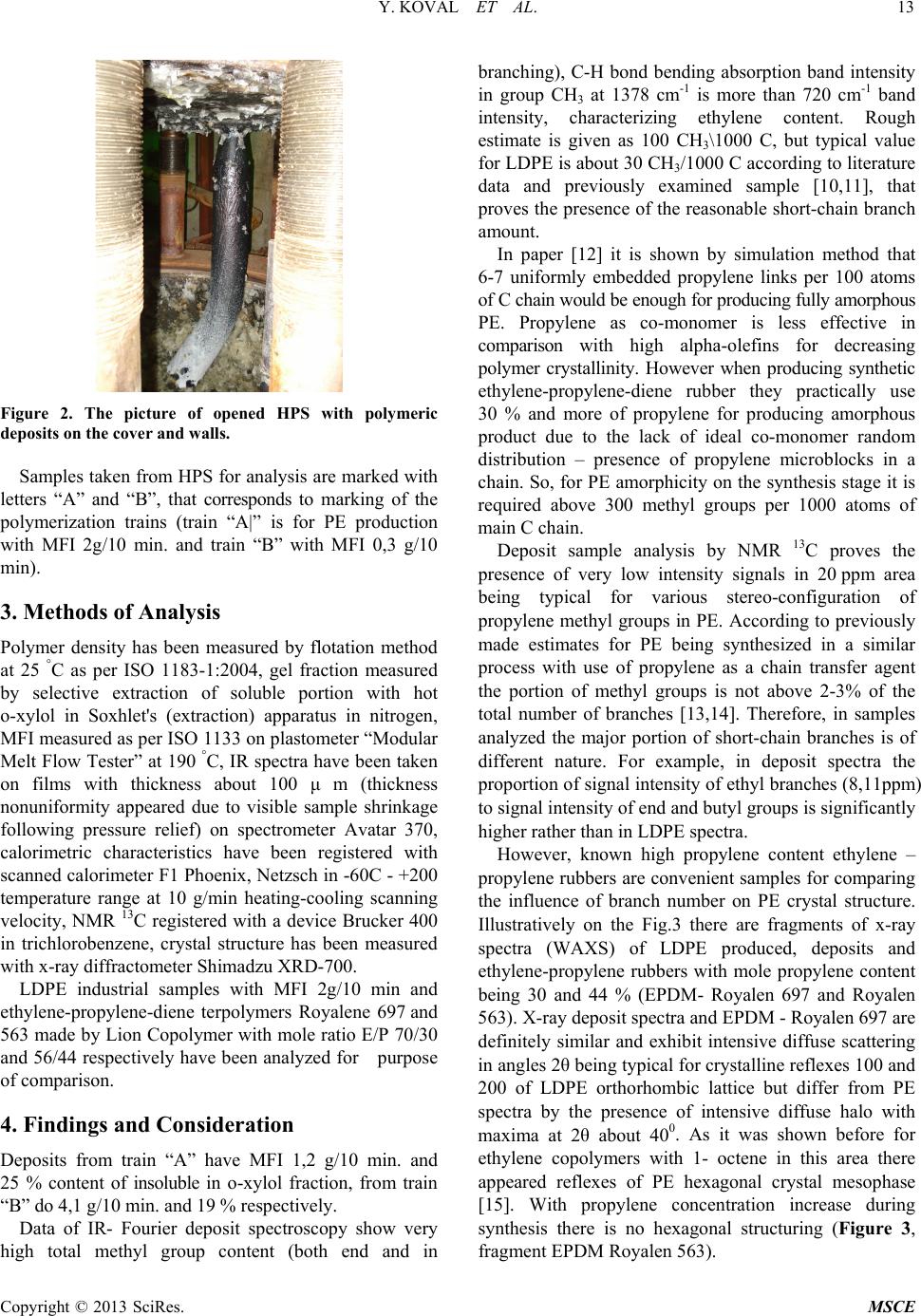
Y. KOVAL ET AL.
Figure 2. The picture of opened HPS with polymeric
deposits on the cover and walls.
Samples taken from HPS for analysis are marked with
letters “A” and “B”, that corresponds to marking of the
polymerization trains (train “A|” is for PE production
with MFI 2g/10 min. and train “B” with MFI 0,3 g/10
min).
3. Methods of Analysis
Polymer density has been measured by flotation method
at 25 °C as per ISO 1183-1:2004, gel fraction measured
by selective extraction of soluble portion with hot
o-xylol in Soxhlet's (extraction) apparatus in nitrogen,
MFI measured as per ISO 1133 on plastometer “Modular
Melt Flow Tester” at 190 °C, IR spectra have been taken
on films with thickness about 100 μ m (thickness
nonuniformity appeared due to visible sample shrinkage
following pressure relief) on spectrometer Avatar 370,
calorimetric characteristics have been registered with
scanned calorimeter F1 Phoenix, Netzsch in -60С - +200
temperature range at 10 g/min heating-cooling scanning
velocity, NMR 13C registered with a device Brucker 400
in trichlorobenzene, crystal structure has been measured
with x-ray diffractometer Shimadzu XRD-700.
LDPE industrial samples with MFI 2g/10 min and
ethylene-propylene-diene terpolymers Royalene 697 and
563 made by Lion Copolymer with mole ratio E/P 70/30
and 56/44 respectively have been analyzed for purpose
of comparison.
4. Findings and Consideration
Deposits from train “A” have MFI 1,2 g/10 min. and
25 % content of insoluble in o-xylol fraction, from train
“B” do 4,1 g/10 min. and 19 % respectively.
Data of IR- Fourier deposit spectroscopy show very
high total methyl group content (both end and in
branching), C-H bond bending absorption band intensity
in group CH3 at 1378 cm-1 is more than 720 cm-1 band
intensity, characterizing ethylene content. Rough
estimate is given as 100 СН3\1000 С, but typical value
for LDPE is about 30 CH3/1000 C according to literature
data and previously examined sample [10,11], that
proves the presence of the reasonable short-chain branch
amount.
In paper [12] it is shown by simulation method that
6-7 uniformly embedded propylene links per 100 atoms
of C chain would be enough for producing fully amorphous
PE. Propylene as co-monomer is less effective in
comparison with high alpha-olefins for decreasing
polymer crystallinity. However when producing synthetic
ethylene-propylene-diene rubber they practically use
30 % and more of propylene for producing amorphous
product due to the lack of ideal co-monomer random
distribution – presence of propylene microblocks in a
chain. So, for PE amorphicity on the synthesis stage it is
required above 300 methyl groups per 1000 atoms of
main C chain.
Deposit sample analysis by NMR 13C proves the
presence of very low intensity signals in 20 ppm area
being typical for various stereo-configuration of
propylene methyl groups in PE. According to previously
made estimates for PE being synthesized in a similar
process with use of propylene as a chain transfer agent
the portion of methyl groups is not above 2-3% of the
total number of branches [13,14]. Therefore, in samples
analyzed the major portion of short-chain branches is of
different nature. For example, in deposit spectra the
proportion of signal intensity of ethyl branches (8,11ppm)
to signal intensity of end and butyl groups is significantly
higher rather than in LDPE spectra.
However, known high propylene content ethylene –
propylene rubbers are convenient samples for comparing
the influence of branch number on PE crystal structure.
Illustratively on the Fig.3 there are fragments of x-ray
spectra (WAXS) of LDPE produced, deposits and
ethylene-propylene rubbers with mole propylene content
being 30 and 44 % (EPDM- Royalen 697 and Royalen
563). X-ray deposit spectra and EPDM - Royalen 697 are
definitely similar and exhibit intensive diffuse scattering
in angles 2θ being typical for crystalline reflexes 100 and
200 of LDPE orthorhombic lattice but differ from PE
spectra by the presence of intensive diffuse halo with
maxima at 2θ about 400. As it was shown before for
ethylene copolymers with 1- octene in this area there
appeared reflexes of PE hexagonal crystal mesophase
[15]. With propylene concentration increase during
synthesis there is no hexagonal structuring (Figure 3,
fragment EPDM Royalen 563).
Copyright © 2013 SciRes. MSCE